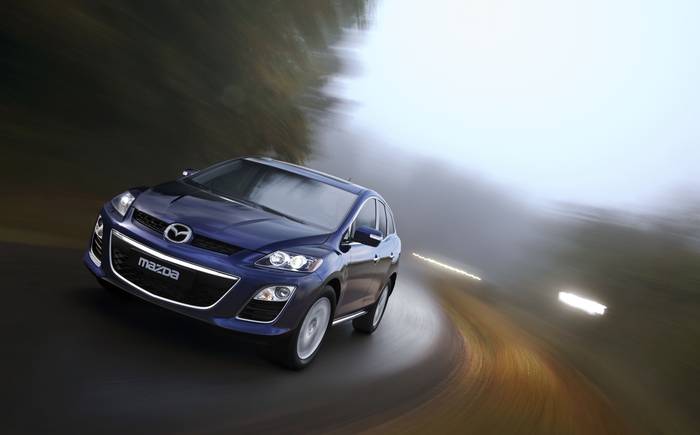The Clarkson review: Mazda CX-7 (2011)

How you feel when you arrive somewhere in a car is more important than how you feel on the way. On the way, a car is just a tool, but when you get to your destination, and your hosts are waiting for you, and people you know are looking, that’s when the true value of your wheels shines through. I went to a party the other night, and when I arrived, there were 12 Range Rovers already parked in the drive. Mine made it 13. This made me feel gooey and part of a club: like I’d read the social circles in which I move well and that I was keeping up.
The drive to the party had been normal — a row about why it had taken my wife so long to get ready and some light rain — but the arrival was terrific. However, then the 14th car arrived. It was my friend Alex. He screeched into the yard in a seven-year-old Renault Clio and that looked bad. He knew this. So to make up for the deficiency of the rust bucket, he didn’t just pull up and park. He kept his foot on the throttle, turned the wheel slightly and applied the handbrake. This was a cool thing to do, and it more than made up for the brownness of his wheels.
Search for and buy a Mazda CX-7 on driving.co.uk
The fact is that, if you exclude the very cheap and the very expensive, all cars feel broadly similar to drive. A BMW and a Merc? Essentially, they are the same. A Renault and a Fiat? Same story. Look at the brakes on your car; then go and look at the brakes on your neighbour’s. Both sets are made by the same people in the same factory.
And it’s a similar story with the power steering system and the wiper motor and the shock absorbers. Take the engine in your Mini Cooper S. You may think that it’s lovingly hand-crafted by gnarled old men in Oxfordshire and that BMW is fiercely protective of its secrets. Not so. You will find the same engine in the Peugeot RCZ and the Citroën DS3 Racing. And then there’s the Fiat 500. Lovely little car, so cute and chic and perfect. Except that if you peel away the body, it’s exactly the same as both the Fiat Panda and the Ford Ka. Do you want a Ford Panda or a Fiat Ka? Why not? They will drive and feel and go just like the 500. But they will not feel even remotely similar when you arrive at your friend’s house because your friend will not come out and go, “Aaah.” As they would if you pulled up in the Fifties throwback.
All of this means that brand image is critical. But even more important than that is the styling. And that brings me on to the Mazda CX-7 that you see in the photographs this morning. There are now many crossover 4×4 family school-run SUV MPV whatever you want to call them vehicles, and for the most part they are all absolutely terrible. Pull up at anybody’s house in any one of them and I can pretty much guarantee that no one will open the door. I’d rather be friends publicly with Piers Morgan than friends with someone who has a crossover car. Crossover cars are for fools. They offer no more space inside than a normal family hatchback but they are perceived by the idiots who buy them to be tougher. Why? They are made from the same grade of steel and the same quality of plastic and they have the same suspension components. You are fooled by the high-riding stance into thinking that they have been built to take on the Kalahari but they have not. All the tall stance means is worse handling and inferior fuel consumption.
The trouble is that crossover cars do look quite good, in a Tonka toy sort of way. They look better than a Ford Focus. More interesting. They are like accountants underneath but they are wearing lumberjack shirts and Timberlands. It makes them stand out. And just about the best-looking of all of them is the four-wheel-drive Mazda CX-7. I love the flared arches and the way its window line tapers. If you were in the market for a car like this, you might well see one in your local town and think: “Mmmm. That’ll do nicely.” I’m with you. I liked the old model quite a lot. But the new one has a few issues. Take a deep breath — we’re going in … First of all, you would imagine that, being Japanese, it is built to outlast Scotland’s mountains. Well, you will be disappointed to note that when you slam the doors, they sort of clang, and that when the electric window goes up, it crashes into the door frame with such a thud you think the glass will break. Oh, and the offside wiper hit the A pillar on every sweep, which was deeply irritating. It was more relaxing to drive in the rain with the wipers turned off, seeing where I was going using nothing but the Force.
Then there’s the gearchange. First, third and reverse are separated by a millimetre, so every time you set off you don’t really know whether you will go forwards, go backwards or stall. And stall you will, because the turbocharged diesel engine is woeful.
They say it will get from 0 to 60 in 11 seconds, which raises the question: 60 what? Certainly not miles per hour. There doesn’t even seem to be much in the way of torque, normally a pleasant by-product of diesel motoring. On even the slightest incline, you need to change down. Which normally means engaging reverse by mistake. Mazda says the CX-7 produces less nitrous oxide than just about any other car made, which is lovely. But that’s like saying it produces very few eggs or rice pudding. All anyone cares about these days is carbon dioxide. That’s what the tax is based on, and on that front it produces a lot. And don’t think you can get round all these problems by buying a petrol version with an automatic gearbox. Because there’s no such thing. It’s a diesel manual. Or something else. I haven’t finished with the problems yet. The sat nav screen is the size of a Third World postage stamp, the boot is even smaller and there is only enough room in the rear for people who have lost their legs. Now this might just be acceptable if the car were small. But it’s chuffing massive.
So big that it would not fit into the parking space in my local underground car park. I even struggled to fit it into a standard London meter bay. And to make matters worse, you cannot see any of the corners from the driver’s seat.
So, big on the outside, small on the inside, badly made, ill conceived, woefully slow, hard to drive and I wish that were an end to it. But no. It’s also uncomfortable. The only good thing, apart from the alluring looks, is the price. Considering the equipment provided as standard, it’s not bad. But that, be assured of this, does not make it good value. It’s strange. Because most cars these days are fundamentally the same, I thought the days of the truly bad car were a thing of the past. There are boring cars and ugly cars and slothful cars. But bad? Outside America, I haven’t driven one of those for years. I have now, though. So if you must have a CX-7 for whatever reason, please remember to take a leaf out of my mate’s book. Arrive everywhere in it with a handbrake turn.
Search for and buy a Mazda CX-7 on driving.co.uk





